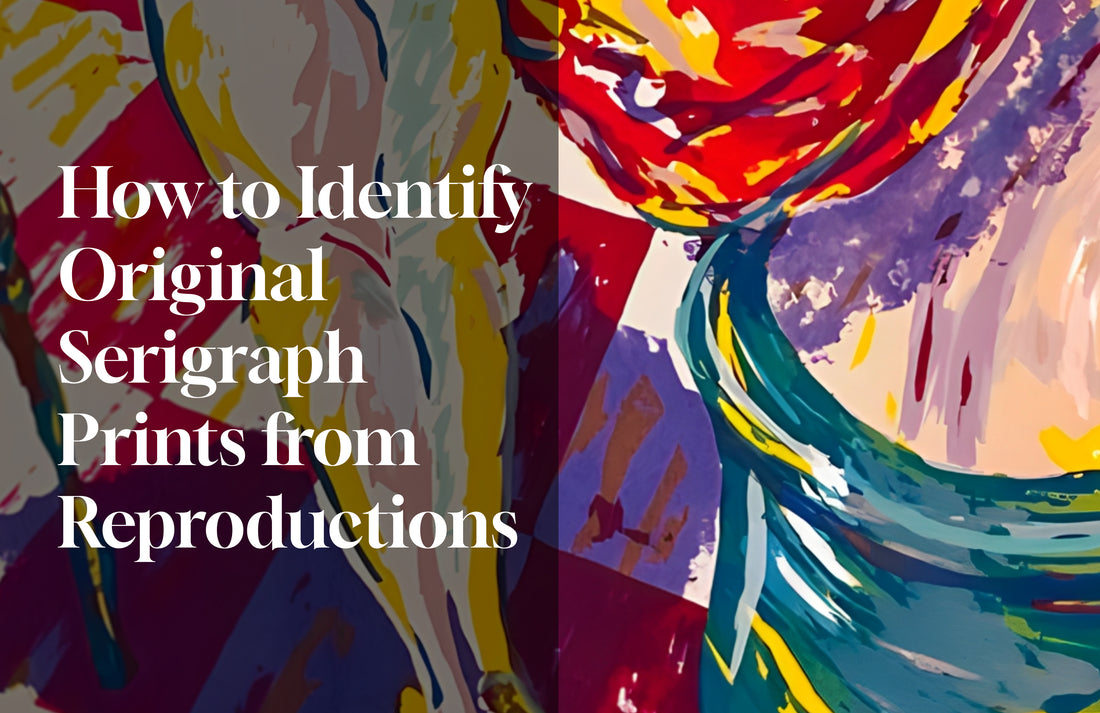
How to Identify Original Serigraph Prints from Reproductions
Share
In the world of art collecting, distinguishing between an original serigraph and a reproduction is essential for making an informed purchase. While they may appear similar, there are notable differences that affect their value, authenticity, and artistic integrity. This guide walks you through each key factor to ensure your confidence when buying serigraph art.
What is a Serigraph?
Serigraphy, also known as screen printing, is a fine art technique that dates back centuries. Unlike traditional printing, an original serigraph is created by pushing ink through a screen onto paper, with each color applied one at a time in layers. This method is labor-intensive and requires a skilled hand, which is why original serigraphs are often limited in edition and hold significant value.
Here are the specific characteristics too look for when identifying an original serigraph:
Examine the Texture and Depth
Original serigraphs have a noticeable texture due to multiple layers of ink:- Look for slightly raised ink surfaces
- Feel for variations in thickness where colors overlap
- Observe a subtle relief effect, especially in areas with bold colors
Examine the Color Vibrancy
In serigraphy, the process of each color being applied separately, results in pure and vibrant hues and subtleties that can’t be achieved through regular printing:
- Look closely at color boundaries for slight misalignments
- You might see thin white lines where colors meet
Check for the Artist's Signature
Authentic serigraphs are often signed in pencil by the artist:- Look for a pencil signature, typically on the bottom right margin of the image.
- Many reproductions may have a signature, but it’s usually printed as part of the image rather than hand-signed by the artist.
Printed signatures on reproductions often appear slightly blurry or misaligned. True serigraphs have hand-signed signatures, which are typically sharper and feel more authentic.
Examine the Edition Number
Original serigraphs are part of a limited edition, indicated by a signed number edition:- Look for a fraction (e.g., 15/100) written in pencil, usually on the bottom left margin of the image.
- This indicates the print's position number in the limited edition
- Reproductions don't have hand-written edition numbers
Assess the Paper Quality
Original serigraphs are printed on high-quality, archival paper, which is designed to last without yellowing or degrading. Art studios use archival-quality paper that’s acid-free, ensuring the longevity of the print. This type of paper is thicker and has a more refined texture than typical reproduction paper:- Look for watermarks or distinctive textures
- The paper should feel substantial and of good quality.
Use Magnification
Under a magnifying glass, the colors in an original serigraph should appear solid, while reproductions often reveal dot patterns:- Original serigraphs show solid areas of color with crisp edges
- You might see slight variations in ink density
- Reproductions often reveal tiny dot patterns (especially in older reproductions) or pixelation in digital prints when viewed up close
Checking the color consistency under magnification is a simple way to tell an original apart from a reproduction, especially for vibrant works.
Look for the Printer's Seal
Some serigraphs include a small embossed seal from the studio that printed it. This mark is a sign of quality and authenticity:- This mark indicates the print studio that produced the serigraph
- It's usually found in the margin of the print
- Reproductions rarely include this feature
Consider the Source and Documentation
Provenance is crucial:- Purchase from reputable galleries or dealers
- Ask for certificates of authenticity
- Research the artist's known editions and printing history
Consult an Expert
If you're unsure:- Seek the opinion of a professional art appraiser or print specialist
- They can provide a detailed analysis of the print's authenticity
Conclusion
Original serigraphs are fine art and represent a piece of the artist’s creative expression, often increasing in value over time. They’re also part of the artist’s official body of work, making them collector’s items. Reproductions, while visually appealing, lack the same depth and are generally not regarded as investment pieces.
By familiarising yourself with these characteristics, you'll be better equipped to identify authentic serigraphs and make informed decisions when collecting or purchasing these valuable artworks.
Explore Tiny Gallery's Serigraph Collection of Limited Edition Prints.
